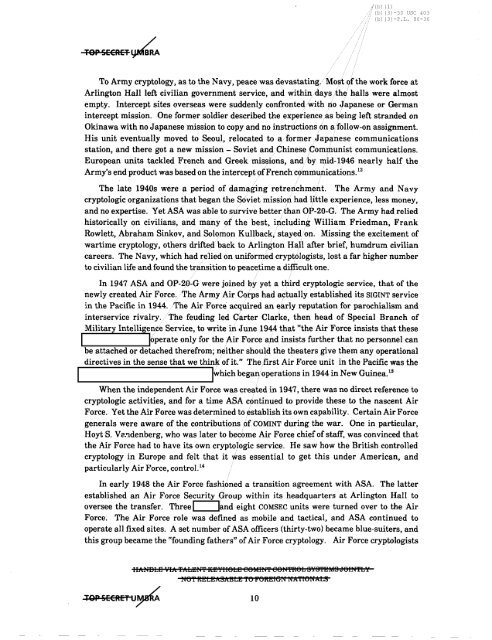American Cryptology during the Cold War - The Black Vault
American Cryptology during the Cold War - The Black Vault
American Cryptology during the Cold War - The Black Vault
You also want an ePaper? Increase the reach of your titles
YUMPU automatically turns print PDFs into web optimized ePapers that Google loves.
; Ib) (1)<br />
Ib) (3) -50 USC 403<br />
Ib) (3) -P.L. 86-36<br />
T9PSECRET~<br />
To Army cryptology, as to <strong>the</strong> Navy, peace was devastating/Most of <strong>the</strong> work force at<br />
Arlington Hall left civilian government service, and within/days /<strong>the</strong> halls were almost<br />
empty. Intercept sites overseas were suddenly confronted/with no Japanese or German<br />
intercept mission. One former soldier described <strong>the</strong> experience/as being left stranded on<br />
Okinawa with no Japanese mission to copy and no instructionson a/follow-on assignment.<br />
His unit eventually moved to Seoul, relocated to a/former /Japanese communications<br />
station, and <strong>the</strong>re got a new mission- Soviet and.Chinese Communist communications.<br />
European units tackled French and Greek missions, and/by mid-1946 nearly half <strong>the</strong><br />
Army's end product was based on <strong>the</strong> intercept of French communications. 12<br />
<strong>The</strong> late 1940s were a period of damaging retrep.chment. <strong>The</strong> Army and Navy<br />
cryptologic organizations that began <strong>the</strong> Soviet mission had little experience, less money,<br />
and no expertise. Yet ASA was able to survive better/than OP-20-G. <strong>The</strong> Army had relied<br />
historically on civilians, and many of <strong>the</strong> best, including William Friedman, Frank<br />
Rowlett, Abraham Sinkov, and Solomon Kullback, stayed/on. Missing <strong>the</strong> excitement of<br />
wartime cryptology, o<strong>the</strong>rs drifted back to Arlington Hall after brief, humdrum civilian<br />
careers. <strong>The</strong> Navy, which had r.elied on uniformed cryptologists, lost a far higher number<br />
to civilian life and found <strong>the</strong> transition to peacetime a difficult one.<br />
In 1947 ASA and OP-20-G were joined by yet a third cryptologic service, that of <strong>the</strong><br />
newly created Air Force./<strong>The</strong> Army Air Corps had actually established its SIGINT service<br />
in <strong>the</strong> Pacific in 1944. /<strong>The</strong> Air Force acquired an early reputation for parochialism and<br />
interservice rivalry./<strong>The</strong> feuding led Carter Clarke, <strong>the</strong>n head of Special Branch of<br />
Military Intelligence Service, to write in June 1944 that "<strong>the</strong> Air Force insists that <strong>the</strong>se<br />
I<br />
loperate only for <strong>the</strong> Air Force and insists fur<strong>the</strong>r that no personnel can<br />
be attached or detached <strong>the</strong>refrom; nei<strong>the</strong>r should <strong>the</strong> <strong>the</strong>aters give <strong>the</strong>m any operational<br />
directives in <strong>the</strong> sense that we think ofit." <strong>The</strong> first Air Force unit in <strong>the</strong> Pacific was <strong>the</strong><br />
_____________.....Ilwhich beganoperations in 1944 in New Guinea. 13<br />
When <strong>the</strong> independent Air Force was created in 1947, <strong>the</strong>re was no direct reference to<br />
cryptologic activities, and for a time ASA continued to provide <strong>the</strong>se to <strong>the</strong> nascent Air<br />
Force. Yet <strong>the</strong> Air Force was determined to establish its own capability. Certain Air Force<br />
generals were aware of <strong>the</strong> contributions of COMINT <strong>during</strong> <strong>the</strong> war. One in particular,<br />
Hoyt S. Ve.'1denberg, who was later to become Air Force chiefof staff, was convinced that<br />
<strong>the</strong> Air Force had to have its own cryptologic service. He saw how <strong>the</strong> British controlled<br />
cryptology in Europe and felt that it was essential to get this under <strong>American</strong>, and<br />
particularly Air Force, control. 14<br />
In early 1948 <strong>the</strong> Air Force fashi(med a transition agreement with ASA. <strong>The</strong> latter<br />
established an Air Force Security Group within its headquarters at Arlington Hall to<br />
oversee <strong>the</strong> transfer. Three c::::::::Jand eight COMSEC units were turned over to <strong>the</strong> Air<br />
Force. <strong>The</strong> Air Force role was defined as mobile and tactical, and ASA continued to<br />
operate all fixed sites. A set number ofASA officers (thirty-two) became blue-suiters, and<br />
this group became <strong>the</strong> "founding fa<strong>the</strong>rs" ofAir Force cryptology. Air Force cryptologists<br />
I1AUBLEl VIA 'fALElU'f IU..1YII6LEl e6fdHtf'f e6Itf'fft6L S-YS'fElMSd'6Htf'fLY<br />
'lOP SECRET u~ 10
















